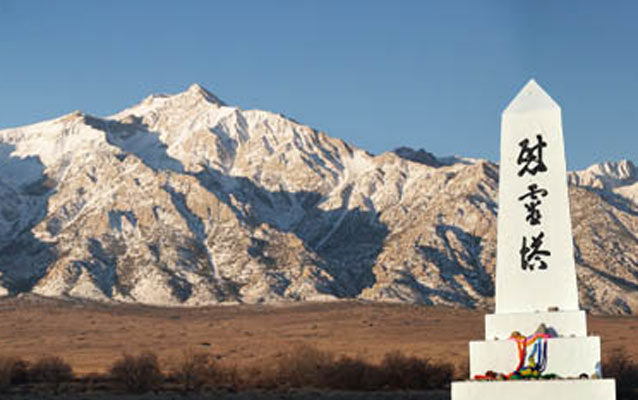Last updated: April 9, 2021
Place
Manzanar National Historic Site

NPS
Manzanar National Historic Site was established by Congress (PL 102-248) on March 3, 1992, to “provide for protection and interpretation of historical, cultural, and natural resources associated with the relocation of Japanese Americans during World War II.” While Manzanar is best known for its wartime history, its layers of the past echo the larger themes of American history, including displacement of native peoples, the settlement of ranchers and farmers, water wars, and the consequences of prejudice.
It was—and is—a place of significance for the Paiute and Shoshone peoples who have lived in this valley for centuries. After 1860, the U.S. Army killed some Paiutes and drove many others out of the valley. Some Paiutes eventually returned, and their descendants maintain traditional affi liation and uses in the Owens Valley.
In the early 1900s, farmers planted thousands of apple and other fruit trees in the town of Manzanar (Spanish for “apple orchard”), just as the city of Los Angeles was building an aqueduct to carry the valley’s water 200 miles south. In the mid1920s, Los Angeles bought out Manzanar’s farmers, and in 1941, Inyo County declared the town abandoned.
No one could foresee how quickly and dramatically Manzanar would change in the aftermath of Japan’s attack on Pearl Harbor on December 7, 1941. Newspapers, politicians, and labor leaders lobbied for action against people of Japanese ancestry, intensifying long-standing anti-Japanese prejudice on the West Coast. President Franklin D. Roosevelt signed Executive Order 9066 on February 19, 1942, authorizing the military to forcibly exclude “any or all persons” from the West Coast. Under the direction of Lt. General John L. Dewitt, the army applied the order to everyone of Japanese ancestry, including more than 70,000 U.S. citizens. Half were under the age of 18. Ultimately, the government deprived 120,000 people of their freedom by forcing them to relocate.
Those exiled to Manzanar were largely from the Los Angeles area and ranged in age from newborns to an 86-year-old widower. They were from cities and farms, young and old, rich and poor. Most had never been to Japan. They had only days or weeks to prepare. Businesses closed, classrooms emptied, friends separated. The U.S. government incarcerated a total of 11,070 people at Manzanar between March 21, 1942 and November 21, 1945. They lived within a 540-acre housing section, divided into 36 blocks. Military police manned eight guard towers and patrolled the camp’s barbed-wire perimeter fence. People crowded into barracks apartments, ate in communal mess halls, washed their clothes in public laundry rooms, and shared latrines and showers that aff orded almost no privacy. Within these exposed and cramped conditions, 188 couples married, 541 babies were born, and 150 people died.
The camp closed in November 1945, three months after World War II ended. The government sold most of the structures and equipment as surplus. Concrete and rock features such as gardens and basements were buried. Manzanar’s prewar orchards, revived by Japanese Americans, again were abandoned. Time passed and much of Manzanar was further buried, both in sand and in memory. Many people chose not to talk about it.
Buddhist and Christian ministers returned each year to the Manzanar cemetery to remember the dead. They gathered around the stark white obelisk that had been constructed in 1943, inscribed with characters meaning “soul consoling tower.” In 1969, a group came to the cemetery on their own pilgrimage of healing and remembrance. With the formation of the Manzanar Committee, this pilgrimage grew into an annual event attended by thousands. In 1972, the Manzanar Committee successfully lobbied to have Manzanar recognized as a California State Landmark. Later eff orts resulted in the site’s 1976 listing on the National Register of Historic Places and its 1985 designation as a national historic landmark. The advocacy of the Manzanar Committee ultimately resulted in the establishment of Manzanar National Historic Site in 1992.
In 1983, nearly 40 years after the confi nement ended, the Commission on the Wartime Relocation and Internment of Civilians concluded: “Executive Order 9066 was not justifi ed by military necessity. . . . The broad historical causes that shaped these decisions were race prejudice, war hysteria and a failure of political leadership.”
Today, the National Park Service preserves 814 of the 5,415 acres that comprised the Manzanar War Relocation Center. The historic site includes the housing area, the administrative area where War Relocation Authority (WRA) staff lived and worked, the military police compound, the chicken ranch, the hospital site, and the cemetery. Most of the buildings are gone, but many features remain, including historic orchards and numerous Japanese gardens and ponds.
Other features are buried, yet come to life through historic photos, artwork, archives, and hundreds of oral history interviews. The National Park Service restored the former camp auditorium to serve as a visitor center and park headquarters. A restored World War II-era mess hall and two reconstructed barracks in Block 14 (adjacent to the auditorium) feature exhibits on daily life and the many changes and challenges people faced at Manzanar. The National Park Service has also reconstructed one of the eight guard towers, along with the barbed-wire fence that surrounded the living area. More than 80,000 people visit the national historic site each year.
Manzanar became a national historic site because people whose lives had been aff ected by it vowed that such an injustice should never happen again, to any group in this country. A visit to Manzanar is an invitation to consider our Constitution and the protections it promises at a place where—not so long ago—they were largely ignored.
A project through the Save America's Treasures Grant Program, which helps preserve nationally significant historic properties and collections, funded work to restore the perimeter fence around the camp cemetery in 1999.
